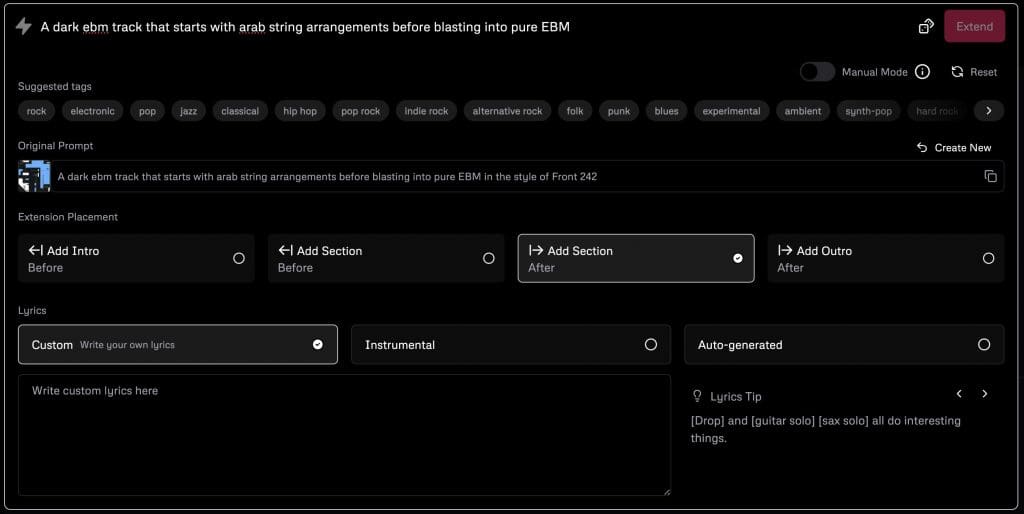

A group of former Google DeepMind developers released the beta version of their AI music tool Udio on Wednesday. The tool has certainly lived up to the significant buzz it generated over the past few months in the form of all kind of rumours, surpassing many expectations with its capabilities.
Here’s how Udio works. To create a track, you first type in a prompt. If you’re not sure what to type try clicking on the dice icon to populate the prompt box with a random example prompt which consists of a combination of free-form text and tags. Based on that, Udio creates two different 33 second tracks.
As far as lyrics is concerned, you can enter your own or have them AI generated. Vocals are generated in various languages, including Japanese and Russian (not the most attractive choice we’d say these days).
Afterwards, you can further work on the track or extend it by adding extra parts. Another cool feature of Udio is remixing, which generates a subtle (or not so subtle) variation of an existing clip.
The tool is currently free, and users can create up to 1200 tracks per month.
Good to know: Udio does NOT generate songs using artists’ voices and under the hood the style reference is replaced with a set of relevant tags.
Future Udio developments
The developers are primarily focusing on improving sound quality (which is not optimal right now) and adding more languages for now: “Our v1 model is capable, but not perfect. We’re iterating quickly, and working on longer samples, improved sound quality, supporting more languages, and next-generation controllability. Stay tuned for more features and improvements coming soon.”
Eventually, more tools will become available for musicians, including the ability to easily add external tracks. And especially this last thing could be interesting to see what it will be able to do. Suppose you upload a demo and let the AI tool work further on it, present a chorus, if that is what you are missing etc..
Introducing Udio, an app for music creation and sharing that allows you to generate amazing music in your favorite styles with intuitive and powerful text-prompting.
— udio (@udiomusic) April 10, 2024
1/11 pic.twitter.com/al5uYAsU5k
So how does Udio sound for industrial music?
The below track was created with Udio (plus cut-edits in FL20) with no additional effects or elements added after rendering. In total 6 snippets were rendered and the whole took this user 45 minutes including the Udio rendering. The prompt used to generate the tracks was this one: “an electronic body music song, in the style of front 242, from 1986, with lyrics about a quite unusual dawn.”
Key is the quality of prompts you give so the tool can really well understand what you expect.
However, no matter how detailed your text prompts are, they cannot fully define an actual piece of music because the same text can describe an infinite number of possible audio tracks. That’s why to get close to the music idea you have in your head you might want to create multiple clips with identical prompts (and other settings). But even that is often not enough, that’s why the state of the prompt box doesn’t reset after you click Create. This makes it easy to queue more generations with or without tweaks.
If you don’t feel like continuing working on the same prompt, click Reset – the prompt box will reset to its default empty state. A good opportunity to try something different.
We are at the moment testing out the tool to see how far it can be stretched or if it stays rather limited in output, but the first results are rather promising.

Clear is that once Udio rolls out the full quality version of its tool that we will see a lot of AI only music projects launching ‘their songs’ on the market. We are not so sure that Spotify, Apple, Deezer will welcome a new flood of tracks into their system although Spotify said that they have no plans to introduce an outright ban on AI-generated music.
The post Udio AI music tool will revolutionize the (industrial) music industry – Available now first appeared on SIDE-LINE.
Original Source: SIDE-LINE
